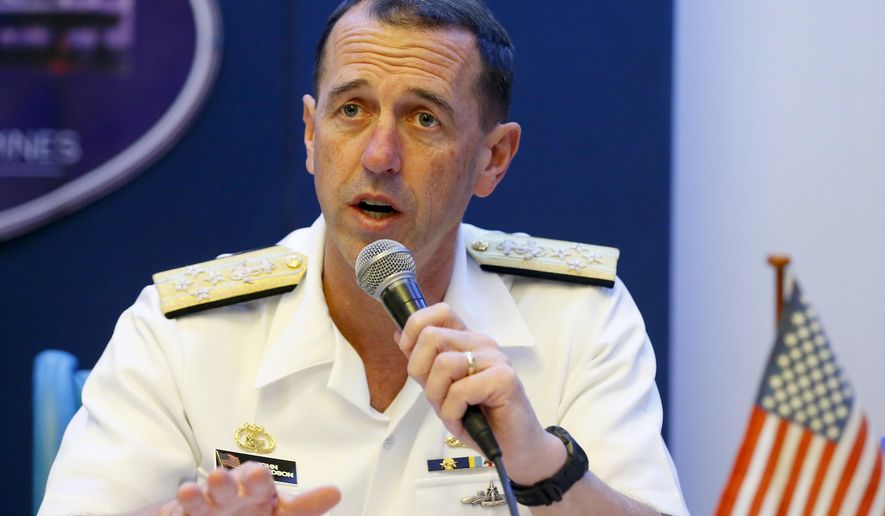BEIJING (AP) - The U.S. Navy’s top officer will visit China starting Sunday amid increasing frictions in the South China Sea and other tensions underscoring their rivalry for dominance in Asia.
Chief of Naval Operations Adm. John Richardson will meet with his counterpart Vice Adm. Shen Jinlong and leaders of China’s Central Military Commission during his visit to Beijing and the eastern city of Nanjing lasting through Wednesday, the Navy said.
The goal of the visit, Richardson’s second as head of operations, is to “continue a results-oriented, risk reduction focused dialogue” between the two militaries, the Navy said.
“A routine exchange of views is essential, especially in times of friction, in order to reduce risk and avoid miscalculation,” the release quoted Richardson as saying. “Honest and frank dialogue can improve the relationship in constructive ways, help explore areas where we share common interests, and reduce risk while we work through our differences.”
Richardson and Shen met previously at the 2018 International Seapower Symposium in the U.S. and have held three discussions via video teleconference, the most recent in December, the release said.
China has long chafed at the robust U.S. naval presence in its region, seeing that as a key component of a strategy to contain its development.
In recent years, the South China Sea has become the main area of contention, home to islands, rich fishing grounds, undersea mineral deposits and shipping lanes through which pass an estimated $5 trillion in goods annually. China claims virtually the entire waterway on historical grounds and has strengthened its hold through the fortification of its island holdings and the construction and man-made outposts by piling sand and concrete atop coral reefs.
Five other governments also exercise overlapping claims in the area and while the U.S. takes no formal position on sovereignty, it insists on the right to navigation and overflight, including in air and waters within the territorial limits surrounding China’s holdings.
Such freedom of navigation operations intended to assert such rights have enraged China, which has vowed to take whatever measures to thwart them.
While those usually involve the dispatch of ships and aircraft to warn off U.S. vessels, in late September, a Chinese destroyer came perilously close to the USS Decatur in the South China Sea in what the U.S. Navy called an “unsafe and unprofessional maneuver.” Navy officers downplayed the incident, calling it unfortunate, rare and something they’d like to avoid in future.
Richardson has said such patrols highlight the U.S. position against “illegitimate maritime claims.”
Chinese navy academy researcher Senior Capt. Zhang Junshe said Wednesday that Beijing may further fortify the outposts depending on perceived threats.
While the sides have sought to boost understanding and signed agreements to handle unexpected confrontations at air and sea, deep mistrust lingers.
Last summer, Washington disinvited China from a major U.S.-sponsored naval exercise in what it called “an initial response” to China’s militarization of the South China Sea.
The Pentagon cited strong evidence that China has deployed anti-ship missiles, surface-to-air missile systems and electronic jammers to contested areas in the Spratly Islands. It called on China to remove these systems. Despite strong mutual suspicions, the U.S. had included China in the past two versions of the naval exercise known as Rim of the Pacific, or RimPac, in 2014 and 2016.
China has also warned the U.S. against further upgrading military ties with Taiwan. China threatens to use force against the self-governing island to assert its claim of sovereignty. Under President Donald Trump, the U.S. has taken incremental moves to bolster ties with the island, including renewed arms sales and upgraded contacts between officials.
Chinese President Xi Jinping, who also heads the Central Military Commission, said in a Jan. 2 address that the ruling communists “made no promises to abandon the use of force,” but added that was directed at those advocating formal independence for the island that split from the mainland amid civil war in 1949, along with any foreign forces that might intervene.
Adding to the tensions, China and the U.S. are locked in a tariff dispute that shows little sign of dissipating and Washington has repeatedly accused Beijing of running a cyberespionage campaign to capture commercial and government secrets.




Please read our comment policy before commenting.